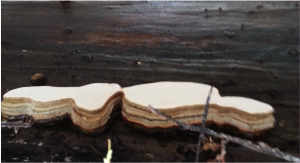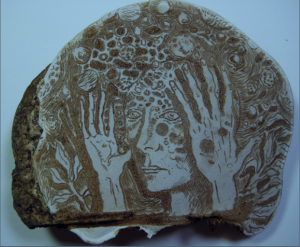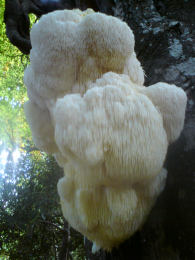By Shelby Burnham
Aristotle (384-322) reported a mysterious light, distinct from fire, emanating light from decaying wood. Pliny the Elder (23-79 AD) also mentioned feasting on a glowing, sweet fungus found on trees in France (Kimbrough, L). Glow in the dark mushrooms are unique to the fungal kingdom for their mysterious “cold light”; bioluminescent fungi will continue to intrigue generations to come.
The most common reports about bioluminescence are “glowing wood” in forests at night. The most abundant and diverse bioluminescence are found in tropical rain forests, they are typically small and grow on leaf litter or rotting wood (Herring, P). Some countries are great places to hunt for bioluminescent fungi, these countries include: Brazil, Dominican Republic, Jamaica, Japan, Malaysia and Puerto Rico (Pescovitz, D). In these countries, scientists look not up at the stars but down to see a starry filled ground. The temperate forests in North America also have bioluminescent fungi. Two examples of bioluminescent fungi that grow in temperate forests of North American are: Omphaloutus olearius (the jack-o-lantern mushroom), and Armillaria mellea (the honey mushroom). O. olearius caps and gills glow in the dark but only the mycelium of the A. mellea glows in the dark (Kimbrough, L). All bioluminescent fungi emit light 24 hours a day but are only luminescent at night, preferably on a new moon night (Herring, P).
Photo by: National Geographic / Darlyne A. Murawski
Scientists suggest that mushrooms illuminate different organs for different reasons. Some evidence shows that certain nocturnal insects and mammals are attracted to the glowing light and therefore assist the fungi in spore dispersal. There is controversy over the idea that illuminating is more effective. Most bioluminescent species are found in the water, they use their luminescent tricks for communication, hunting and camouflage but their molecular structure is very different than a mushroom (Untamed Science). In the article called “Freaky Fungi Glow in the Dark” from the University of Sao Paulo, the authors state that there are 85,000 described species in the Fungi Kingdom, and only 65 species in the ent
ire Fungi Kingdom are known to be luminescent. All of the 65 luminescent fungi species are mushrooms that have thin-walled, white spores, and all are white rot fungi capable of digesting both cellulose and lignin in plant debris. All luminescent fungi are in the Basidiomycota phylum, and 70% of them are Mycenas. At the San Francisco State University, professor and avid mycologist Dr. Dennis Desjardin has discovered over 200 new species of fungi, and nearly 1/4 of all the luminescent fungi (Desjardin, D).
How does bioluminescence work? Bioluminescence are the result of a molecule called luciferin coming in contact with water and oxygen. When water and oxygen are prese
nt, the molecule luciferin is activated and thus becomes a luciferase enzyme. This reaction produces energy, and this energy excites the electrons in the luciferin molecule (Hastings, J). This means, the electrons get a little more energy than normal. When the molecules return to their normal state the extra energy gets converted into light. All the energy that bioluminescent mushrooms produces get turned into light, this light is more efficient than a flashlig
ht because they do not produce heat, just pure light. This is where they get their nickname from “Cold Light Mushrooms” (Untamed Science).

A quote from Dr. Dennis Desjardin at the San Francisco University: “There are a few species in temperate habitats that are luminescent, particularly Omphalotus species (jack-o-lantern mushrooms), but they are not very spectacular and it requires patience (sitting for a long time in the dark to let your eyes adjust). The tropics are the best place to see them. Brazil, Southeast Asia and Australia are particularly good places with a variety of luminescent mushroom species. Pick a new moon night during the rainy season, go out at night when it is completely dark, and roam in the forest looking for points of yellowish green light. Donʼt forget, however, that you cannot see a thing in the pitch dark, so youʼll walk into trees, streams, etc, and that there are lots of creatures that are nocturnal, like poisonous snakes, jaguars, necrotic spiders, etc. that need to be avoided! Itʼs lots of fun!” (Kimbrough, L).
This is a video called the “Science of Glowing Mushrooms”
References
Denk, J. (n.d.). Fire fox mushroom (honey mushroom, armillaria mellea). Retrieved from http:// morelmushroomhunting.com/newsletter_july_2009.htm
Desjardin, D. E. (2008). Freaky fungi glow in the dark. LiveScience & National Science Foundation,
Hastings, J. W. (1996). Chemistries and colors of bioluminescent reactions. Elsevier Science,
Herring, P. J. (1994). Luminous fungi. Institute of Oceanographic Sciences, Deacon Laboratory, Brook Road, Wormley, 8(4), 18.
Kimbrough, L. (2013). Why bioluminescent fungi glow in the dark.
Murawski, D. A. (n.d.). Jack-o-lantern mushrooms (omphalotus olearius) glowing green at night.. Retrieved from http://www.artflakes.com/en/products/jack-o-lantern- mushrooms-omphalotus-olearius-glowing-green-at-night
Pescovit, D. (2009). Glow-in-the-dark mushrooms.
Science of Glowing Mushrooms [Web Video]. Retrieved from http://www.youtube.com/user/ UntamedScience?feature=watch



